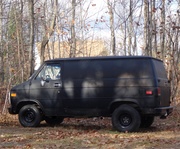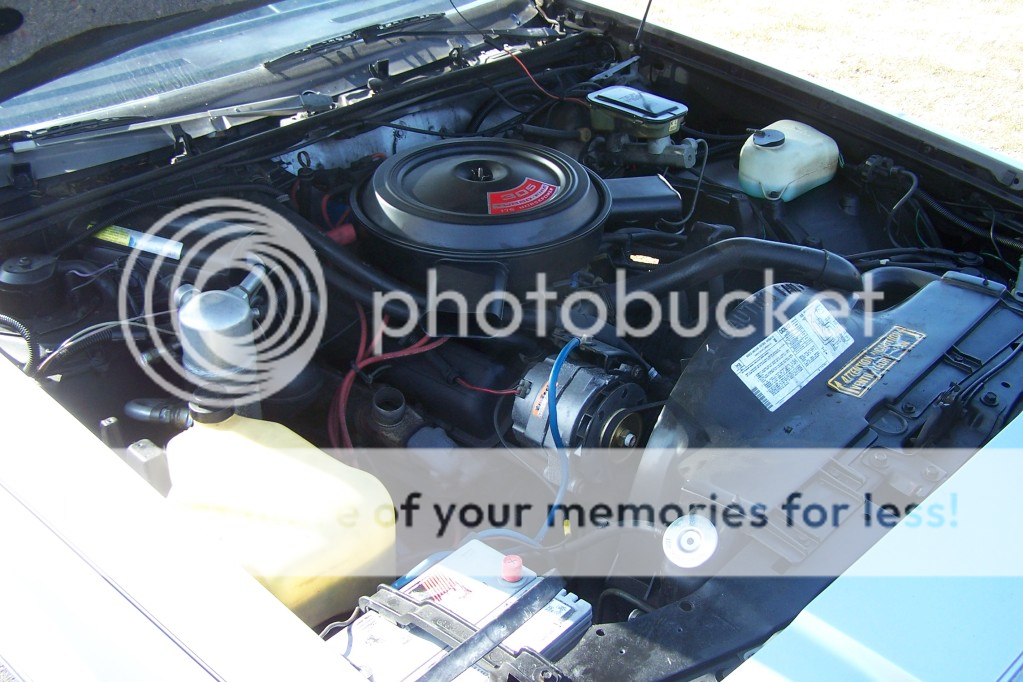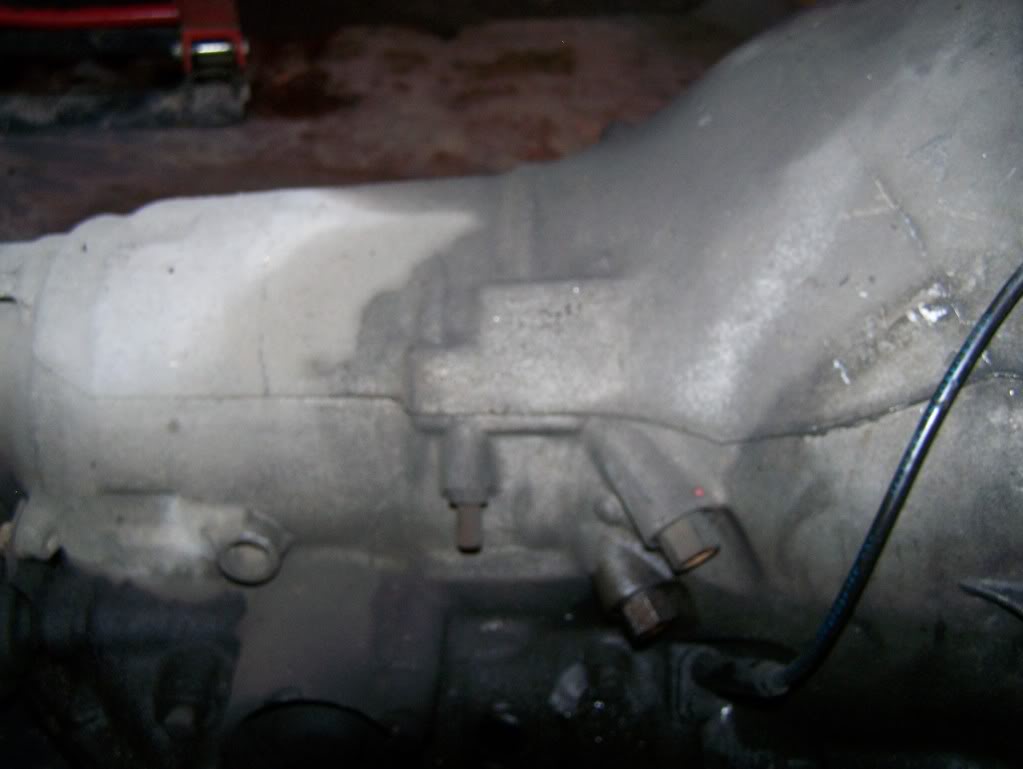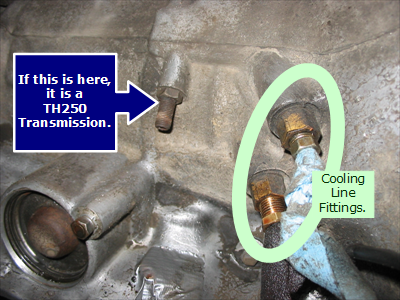Les options du GP!!!!
+2
Revving455
Cadillac Jack
6 participants
Page 1 sur 1
 Les options du GP!!!!
Les options du GP!!!!
Un gars sur le forum américain G-Body a eu l'extrême aimabilité de me faire un breakdown complet de la build sheet du GP!! J'dois l'admettre, ya certaines lignes qui m'ont jeté en bas d'ma chaise comparativement à c'que je PENSAIS avoir!!! En tout cas, j'peux pas avoir meilleur guideline pour faire mon éventuelle restauration!!! Visez un peu ca:
AK1: Deluxe Seat Belts, Color-Coded
A01: Soft-Ray Tint Windshield
A31: Power Windows
A51: Front Buckets, Reclining Driver's
BS1: Acoustical Sound Deadening Pkg.
BX2: Exterior Stainless Trim, Lower Body-Extra Wide.
B32: Floor Mats - Vinyl Front
B33: Floor Mats - Vinyl Rear
B84: Exterior Body Ornamentation, Both Sides
B85: Exterior Body Ornamentation, Exterior Molding Belt Reveal
B96: Wheel Well Opening Stainless Moldingsby
C04: Padded Vinyl Landau Roof
C41: HVAC - Heater w/ Fan (AC Delete)
C49: Rear Window Defogger - Electric
D1A: Gear - Speedo Driven
D35: Dual Sport Mirrors, Driver's Remote/Manual Passenger
D55: Center Console - Floor - Automatic Trans Provisions
D84: Custom - Two Tone Metallic Paint
E5Z: Speedo Adapter Delete
E6E: Speedo Gear Sleeve
E9Z: Speedo Key Delete
F40: Heavy Duty Suspension Package
GH2: Rear Axle - 2.29 Ratio
JM2: Brakes - Brake Booster, Power Front Disc/Rear Drum.
K77: Generator - 56 Amp
L39: Engine - Pontiac V8 4.4L/ 267ci, 2BBL, 115hp @ 4000rpm, 200 @ 2400 torque, 8.3:1CR.
MV4: THM350 - Convertor Clutch
MX1: Automatic Transmission Provisions - Merchandised (base auto trans was THM200)
NM4: Emission System Control - Non-Closed Loop
NM5 : Emission System - Canadian Requirements
NM6: Emission System Recalibration
NY8: Exhaust - Catalytic Convertor Shield
N18: Simulated Wire Wheel Locking Package
N30: Deluxe Interior Steering Wheel
N95: Simulated Wire Wheel Hubcaps
QXY: 14" steel wheel tire size...xxxx
TR9: Interior Lamp Group
UA1: HD Battery
UN9: Radio Supression Equipment
UP8: Stereo Sound Provisions, Dual Front/Dual Rear Speakers
UT1: Generator Warning Tones/Ignition
UX6: Front Dual Speaker Dash Provisions
U05: Dual Horn System
U25: Interior Lamp Rear Courtesy
U27: Interior Lamp Below Dash Courtesy
U28: Interior Lamp Ash Tray Courtesy
U29: Interior Lamp Ceiling Courtesy
U35: Electric Clock, Cluster Instrumentation
U58: Radio - Delco AM/FM Stereo
U76: Windshield Antenna
VK3: Front License Plate Mounting Package
W50: Ornamentation, LJ
W84: Gas, Additional Fuel Order For Delivery (Canada)
YR1: Seat - Front, Deluxe
YS1: Seat - Rear, Deluxe
YT1: Interior Panel Front/Rear Deluxe
YT9: Option Package, Fisher Furnished Parts Rust Prevention
Y83: Grand Prix LJ Package
ZG8: Sales Processing Option (Canada)
Z49: Export - Canadian Modification, Mandatory Base Equipment.
36A: Stripe Color, 2 Tone Pinstripe
36Q: Vinyl Top Molding Trim - Color
36T: Vinyl Top - Color
36U: 2 Tone Paint, Primary Color
37L: 2 Tone Paint, Secondary Color
45E: Interior Seat/Panel Color
45I: Interior Trim Color
459: Seat Belt Color
6CW: computer selected spring rate
7CX: computer selected spring rate
8HK: computer selected spring rate
9HN: computer selected spring rate
AK1: Deluxe Seat Belts, Color-Coded
A01: Soft-Ray Tint Windshield
A31: Power Windows
A51: Front Buckets, Reclining Driver's
BS1: Acoustical Sound Deadening Pkg.
BX2: Exterior Stainless Trim, Lower Body-Extra Wide.
B32: Floor Mats - Vinyl Front
B33: Floor Mats - Vinyl Rear
B84: Exterior Body Ornamentation, Both Sides
B85: Exterior Body Ornamentation, Exterior Molding Belt Reveal
B96: Wheel Well Opening Stainless Moldingsby
C04: Padded Vinyl Landau Roof
C41: HVAC - Heater w/ Fan (AC Delete)
C49: Rear Window Defogger - Electric
D1A: Gear - Speedo Driven
D35: Dual Sport Mirrors, Driver's Remote/Manual Passenger
D55: Center Console - Floor - Automatic Trans Provisions
D84: Custom - Two Tone Metallic Paint
E5Z: Speedo Adapter Delete
E6E: Speedo Gear Sleeve
E9Z: Speedo Key Delete
F40: Heavy Duty Suspension Package
GH2: Rear Axle - 2.29 Ratio
JM2: Brakes - Brake Booster, Power Front Disc/Rear Drum.
K77: Generator - 56 Amp
L39: Engine - Pontiac V8 4.4L/ 267ci, 2BBL, 115hp @ 4000rpm, 200 @ 2400 torque, 8.3:1CR.
MV4: THM350 - Convertor Clutch
MX1: Automatic Transmission Provisions - Merchandised (base auto trans was THM200)
NM4: Emission System Control - Non-Closed Loop
NM5 : Emission System - Canadian Requirements
NM6: Emission System Recalibration
NY8: Exhaust - Catalytic Convertor Shield
N18: Simulated Wire Wheel Locking Package
N30: Deluxe Interior Steering Wheel
N95: Simulated Wire Wheel Hubcaps
QXY: 14" steel wheel tire size...xxxx
TR9: Interior Lamp Group
UA1: HD Battery
UN9: Radio Supression Equipment
UP8: Stereo Sound Provisions, Dual Front/Dual Rear Speakers
UT1: Generator Warning Tones/Ignition
UX6: Front Dual Speaker Dash Provisions
U05: Dual Horn System
U25: Interior Lamp Rear Courtesy
U27: Interior Lamp Below Dash Courtesy
U28: Interior Lamp Ash Tray Courtesy
U29: Interior Lamp Ceiling Courtesy
U35: Electric Clock, Cluster Instrumentation
U58: Radio - Delco AM/FM Stereo
U76: Windshield Antenna
VK3: Front License Plate Mounting Package
W50: Ornamentation, LJ
W84: Gas, Additional Fuel Order For Delivery (Canada)
YR1: Seat - Front, Deluxe
YS1: Seat - Rear, Deluxe
YT1: Interior Panel Front/Rear Deluxe
YT9: Option Package, Fisher Furnished Parts Rust Prevention
Y83: Grand Prix LJ Package
ZG8: Sales Processing Option (Canada)
Z49: Export - Canadian Modification, Mandatory Base Equipment.
36A: Stripe Color, 2 Tone Pinstripe
36Q: Vinyl Top Molding Trim - Color
36T: Vinyl Top - Color
36U: 2 Tone Paint, Primary Color
37L: 2 Tone Paint, Secondary Color
45E: Interior Seat/Panel Color
45I: Interior Trim Color
459: Seat Belt Color
6CW: computer selected spring rate
7CX: computer selected spring rate
8HK: computer selected spring rate
9HN: computer selected spring rate

Cadillac Jack- Habitué

- Date d'inscription : 13/10/2009
 Re: Les options du GP!!!!
Re: Les options du GP!!!!
Sa en fait des options, on croirais pas ça !!
Il doit pas être trop dur sur le gas !
Il doit pas être trop dur sur le gas !
_________________
Les hommes politiques et les couches doivent être changés souvent et pour les mêmes raisons. (Sir George Bernard Shaw)

Kustom- Accro

- Date d'inscription : 12/10/2009
 Re: Les options du GP!!!!
Re: Les options du GP!!!!
Merci Revving350!! Kustom, non pas du tout!!! Même en allant travailler avec, j'réussis pas à vider TOUTE ma tank en une semaine!!! LOL! Et oui c'est vrai que la liste d'options est assez étonnante!! Moi c'est quand j'ai lu les lignes de suspension et surtout TRANSMISSION que j'en revenais pas!!!! LOL!

Cadillac Jack- Habitué

- Date d'inscription : 13/10/2009
 Re: Les options du GP!!!!
Re: Les options du GP!!!!
oui tes chanceux si ton char a une turbo 350 avec un 267 car le miens avait turbo 250 avec un 305 lg4
mais je regarderait si ta pas la bolts aux dessus des ligne a huile
ces la seule difference visible entre une 250 et 350
mais je regarderait si ta pas la bolts aux dessus des ligne a huile
ces la seule difference visible entre une 250 et 350

firebuick- Incurable

- Date d'inscription : 14/12/2009
 Re: Les options du GP!!!!
Re: Les options du GP!!!!
Sais-tu, Donald, c'est ben la SEULE chose que j'ai jamais pensé à checker!! J'pense m'a aller checker ca demain !!! 


Cadillac Jack- Habitué

- Date d'inscription : 13/10/2009
 Re: Les options du GP!!!!
Re: Les options du GP!!!!
Bon! J'viens juste d'aller me coucher en dessous de GP mais j'ai presque pas d'espace pour voir... À première vue, du peu que jai pu voir autour des lignes, J'AI PAS DE BOLT!! 


Cadillac Jack- Habitué

- Date d'inscription : 13/10/2009
 Re: Les options du GP!!!!
Re: Les options du GP!!!!
àCadillac Jack a écrit:Bon! J'viens juste d'aller me coucher en dessous de GP mais j'ai presque pas d'espace pour voir... À première vue, du peu que jai pu voir autour des lignes, J'AI PAS DE BOLT!!
as tu torque lock up

firebuick- Incurable

- Date d'inscription : 14/12/2009
 Re: Les options du GP!!!!
Re: Les options du GP!!!!
J'viens de demander au gars sur G-Body si le converter clutch veut dire lock up... j'attends la réponse! Par ailleurs, j'ai une ptite valve électro-vacuum dans mon aile de gauche pour la transmission! J'pense que c'en est un mais j'suis pas sûr...j'arrive pas à trouver quoi que ce soit dans mes livres!!...J'continue les fouilles!

Cadillac Jack- Habitué

- Date d'inscription : 13/10/2009
 Re: Les options du GP!!!!
Re: Les options du GP!!!!
Cadillac Jack a écrit:J'viens de demander au gars sur G-Body si le converter clutch veut dire lock up... j'attends la réponse! Par ailleurs, j'ai une ptite valve électro-vacuum dans mon aile de gauche pour la transmission! J'pense que c'en est un mais j'suis pas sûr...j'arrive pas à trouver quoi que ce soit dans mes livres!!...J'continue les fouilles!
oui ces surement sa j ai sa aussi sur mon regal que j ai pas enlever ont peu la voir a coter du canisse a lave vitres


firebuick- Incurable

- Date d'inscription : 14/12/2009
 Re: Les options du GP!!!!
Re: Les options du GP!!!!
EXACT!! J'ai la même valve mais pas de bolt sur ma transmission...En tk j'en ai pas vu malgré le peu d'espace que j'avais vis-à-vis des lignes de cooler pour voir!!!

Cadillac Jack- Habitué

- Date d'inscription : 13/10/2009
 Re: Les options du GP!!!!
Re: Les options du GP!!!!
Cadillac Jack a écrit:EXACT!! J'ai la même valve mais pas de bolt sur ma transmission...En tk j'en ai pas vu malgré le peu d'espace que j'avais vis-à-vis des lignes de cooler pour voir!!!
donc ta transmission est une turbo 350 c lock up
une option car stock dans annee du tiens ces des 200 metric qui sortait avec un 267

firebuick- Incurable

- Date d'inscription : 14/12/2009
 Re: Les options du GP!!!!
Re: Les options du GP!!!!
WOW!!! Ca c'est de la bonne nouvelle!!!! 




Cadillac Jack- Habitué

- Date d'inscription : 13/10/2009
 Re: Les options du GP!!!!
Re: Les options du GP!!!!
MX1: Automatic Transmission Provisions - Merchandised (base auto trans was THM200)
regarde ces ecrit sur ta liste ton char a été monter en provision recevoir une 200 metric

firebuick- Incurable

- Date d'inscription : 14/12/2009
 Re: Les options du GP!!!!
Re: Les options du GP!!!!
Justement...j'me demandais justement c'que ca voulait dire, c't'histoire de provision là... J'ai ca pour PLUSIEURS options sur ma liste!

Cadillac Jack- Habitué

- Date d'inscription : 13/10/2009
 Re: Les options du GP!!!!
Re: Les options du GP!!!!
firebuick a écrit:a moins que converter clutch veux dire lock up
J'viens d'avoir la confirmation! C'est en plein ca!!!


Cadillac Jack- Habitué

- Date d'inscription : 13/10/2009
 Re: Les options du GP!!!!
Re: Les options du GP!!!!
plusieurs option vienne surement en package comme ont dit.
ex=sur les vieux grand-prix ,un lj, avais un tas options qui venais de base avec
ex=sur les vieux grand-prix ,un lj, avais un tas options qui venais de base avec

mafia- Incurable

- Date d'inscription : 28/11/2009
 Re: Les options du GP!!!!
Re: Les options du GP!!!!
Et c'est pas fini!!!! Voici le volet "Histoire'' que le gars m'a refilé!!! Bonne lecture!! 
Source: ''Brother Al'' , G-Body Forum
Computer Selected Spring Rate is the suspension springs. Based on the options you have on the car, GM had a computer that could calculate the load that was being put on each corner of the car and chose a certain spring for that weight. They were "computer selected springs"... I do not know what GM's RPO code breakdowns were for individual spring rates/heights and have never come across an accurate GM breakout of those.
Based on bits I've read and been told, this is what/how I believe these were selected... After each chassis was assembled initially and designated options selected... GM balanced out each corner of each chassis' variances with a selected spring rate & height to keep the car balanced... remember these were mass produced vehicles with a lot of variances in tolerances.. the Springs also varied in their actual height vs design height... The "computer" was likely a simple calculation based on chassis weight, what spring rate was needed, & a combination of offsets in the actual height of each spring... Again, this was needed to offset the variances in each chassis build, its options, & total weight to keep the car level and tracking evenly...
Each spring was rated and then categorized by its actual variance in load rating and actual ride height... ie each spring wasn't exactly the same height so it makes sense that springs were grouped together by their rate and further seperated into smaller RPO Coded bins by their actual ride height...
When the calculations aka "Computer Selections" were made, the designated RPO bins were sourced for the correct springs to level out the chassis.
As for the "LJ", yes "L" was for Luxury....The "J" was for "Model J"... To understand this, you need to know some crucial and some very important pieces of automotive history...
The Model J was originally a model of the infamous Duesenburg... Some of the greatest automobiles ever built. Legendary Cars!
Fast forward to 1967, John Z. DeLorean was the Head of the Pontiac Motor Division (PMD). His GTO idea, originally poo-poo'd by GM Brass, now dominated both the streets and pop culture. Pontiac Sales were spectacular, however, one Pontiac in particular, was sinking fast... Partially because of the GTO's success and the numerous cars copying its big engine/midsize car concept and the all new Mustang Pony Car. The Grand Prix's other short-coming was that its "Sporty Concept" was outdated because it was a "Sporty" Full-Size car trying to attract younger, upscale buyers in a market over-saturated with lots of full size cars. Worse, the Grand Prix competed against two other Full-Size Pontiacs that shared the same platform... the Bonneville and the Catalina... John Z. DeLorean, being an true engineer by trade, was also gifted with the talents of organization, negotiation, elbow rubbing, quality control, sales and marketing, & the ability to see what people (the market) wanted and capitalize on it fully.
In 1967, he undertook a huge personal effort to redesign the Grand Prix into a Personal Luxury Performance Car... with several nods to the Duesenburgs, he borrowed the "Model J" nameplate, and some styling cues. He also came up with the "SJ"..."Sport" performance model and the "LJ" "Luxury" model... Hurst joined in with the "SSJ" Hurst Grand Prix...
The 1969 Grand Prix was DeLorean's newest baby... it featured unique Grand Prix-Only door handles, optional real wood dash inlays, wooden shift knob, wooden rim steering wheel, and wooden center console inlays. The car was shrunken down and put onto a stretched A Body Frame... Which became the first G Body. The body featured a short trunk with a 6ft long hood, the longest hood ever used by GM car, at the time, (another Duesenburg detail). A huge Chrome Grille split by the bumper also hinted at styling cues taken from the Duesenburg. The interior was completely designed around the driver, starting with the Driver's door panel putting power controls at the driver's fingertips, blending somewhat into the dash, which wraps around the driver like a fighter cockpit, & sweeps down into the center console. The Passenger Seat was a pretty much relegated to "Guest Status"... Bucket Seats, Center Console, and a Manual Trans were Standard Items... an automatic transmission and bench seat were secondary options. The Standard Engine was the Pontiac 400, with a few potent 400 & a few powerhouse 428 options... John Z. DeLorean saw to it personally that the Grand Prix had the best quality controls of any GM Division, including Cadillac... Sales of the first "Personal Luxury Car" were highly successful... Unfortunately, John Z. DeLorean was promoted to head up and boost Chevrolet, which was losing market share. In 1970, the Grand Prix was joined by the all new, Oldsmobile Cutlass Supreme and Chevrolet Monte Carlo... Both of which enjoyed their own spectacular sales.. Chrysler and Ford jumped onto the concept and redesigned many of their cars to copy the ideas seen in the Grand Prix.... By 1973, everybody was in on the concept and the era of Macho Machines had begun.
Radio Delete is not the same as Radio Supression.... its actually short for Radio Interference Suppression... it helps keep electrical "noise" from the ignition and ECM/CCC System from affecting the signal quality of the radio...
Radio Delete is just that and has a designated RPO ... it'd be very rare for a Grand Prix to have a factory Radio Delete.
The build sheet and RPOs were not really meant for owner to know...Build Sheets were the build instructions used by the Assembly Line Workers to know what options each car got... GM added the RPOs to all of their products in 1984 to help the Dealership Service Departments know exactly what the car was equipped with... partially because of the "Corporate Drivetrain" changes....
"Provision" is simply that... to tell the assembly line workers to "provision" aka equip a vehicle with certain pieces for a specific option upgrade from the base standard equipment..
Example: The base transmission for your car was the Turbo-Hydramatic 200 "Metric" 3 speed, however it was ordered with the reliable & much better Turbo-Hydramatic 350 3 speed... either it was a smart customer, smart salesman, or the dealership forced the option onto its customers because they got sick of the many TH200 warranty issues... (TH200 is a total piece of crap transmission in stock form).

Source: ''Brother Al'' , G-Body Forum
Computer Selected Spring Rate is the suspension springs. Based on the options you have on the car, GM had a computer that could calculate the load that was being put on each corner of the car and chose a certain spring for that weight. They were "computer selected springs"... I do not know what GM's RPO code breakdowns were for individual spring rates/heights and have never come across an accurate GM breakout of those.
Based on bits I've read and been told, this is what/how I believe these were selected... After each chassis was assembled initially and designated options selected... GM balanced out each corner of each chassis' variances with a selected spring rate & height to keep the car balanced... remember these were mass produced vehicles with a lot of variances in tolerances.. the Springs also varied in their actual height vs design height... The "computer" was likely a simple calculation based on chassis weight, what spring rate was needed, & a combination of offsets in the actual height of each spring... Again, this was needed to offset the variances in each chassis build, its options, & total weight to keep the car level and tracking evenly...
Each spring was rated and then categorized by its actual variance in load rating and actual ride height... ie each spring wasn't exactly the same height so it makes sense that springs were grouped together by their rate and further seperated into smaller RPO Coded bins by their actual ride height...
When the calculations aka "Computer Selections" were made, the designated RPO bins were sourced for the correct springs to level out the chassis.
As for the "LJ", yes "L" was for Luxury....The "J" was for "Model J"... To understand this, you need to know some crucial and some very important pieces of automotive history...
The Model J was originally a model of the infamous Duesenburg... Some of the greatest automobiles ever built. Legendary Cars!
Fast forward to 1967, John Z. DeLorean was the Head of the Pontiac Motor Division (PMD). His GTO idea, originally poo-poo'd by GM Brass, now dominated both the streets and pop culture. Pontiac Sales were spectacular, however, one Pontiac in particular, was sinking fast... Partially because of the GTO's success and the numerous cars copying its big engine/midsize car concept and the all new Mustang Pony Car. The Grand Prix's other short-coming was that its "Sporty Concept" was outdated because it was a "Sporty" Full-Size car trying to attract younger, upscale buyers in a market over-saturated with lots of full size cars. Worse, the Grand Prix competed against two other Full-Size Pontiacs that shared the same platform... the Bonneville and the Catalina... John Z. DeLorean, being an true engineer by trade, was also gifted with the talents of organization, negotiation, elbow rubbing, quality control, sales and marketing, & the ability to see what people (the market) wanted and capitalize on it fully.
In 1967, he undertook a huge personal effort to redesign the Grand Prix into a Personal Luxury Performance Car... with several nods to the Duesenburgs, he borrowed the "Model J" nameplate, and some styling cues. He also came up with the "SJ"..."Sport" performance model and the "LJ" "Luxury" model... Hurst joined in with the "SSJ" Hurst Grand Prix...
The 1969 Grand Prix was DeLorean's newest baby... it featured unique Grand Prix-Only door handles, optional real wood dash inlays, wooden shift knob, wooden rim steering wheel, and wooden center console inlays. The car was shrunken down and put onto a stretched A Body Frame... Which became the first G Body. The body featured a short trunk with a 6ft long hood, the longest hood ever used by GM car, at the time, (another Duesenburg detail). A huge Chrome Grille split by the bumper also hinted at styling cues taken from the Duesenburg. The interior was completely designed around the driver, starting with the Driver's door panel putting power controls at the driver's fingertips, blending somewhat into the dash, which wraps around the driver like a fighter cockpit, & sweeps down into the center console. The Passenger Seat was a pretty much relegated to "Guest Status"... Bucket Seats, Center Console, and a Manual Trans were Standard Items... an automatic transmission and bench seat were secondary options. The Standard Engine was the Pontiac 400, with a few potent 400 & a few powerhouse 428 options... John Z. DeLorean saw to it personally that the Grand Prix had the best quality controls of any GM Division, including Cadillac... Sales of the first "Personal Luxury Car" were highly successful... Unfortunately, John Z. DeLorean was promoted to head up and boost Chevrolet, which was losing market share. In 1970, the Grand Prix was joined by the all new, Oldsmobile Cutlass Supreme and Chevrolet Monte Carlo... Both of which enjoyed their own spectacular sales.. Chrysler and Ford jumped onto the concept and redesigned many of their cars to copy the ideas seen in the Grand Prix.... By 1973, everybody was in on the concept and the era of Macho Machines had begun.
Radio Delete is not the same as Radio Supression.... its actually short for Radio Interference Suppression... it helps keep electrical "noise" from the ignition and ECM/CCC System from affecting the signal quality of the radio...
Radio Delete is just that and has a designated RPO ... it'd be very rare for a Grand Prix to have a factory Radio Delete.
The build sheet and RPOs were not really meant for owner to know...Build Sheets were the build instructions used by the Assembly Line Workers to know what options each car got... GM added the RPOs to all of their products in 1984 to help the Dealership Service Departments know exactly what the car was equipped with... partially because of the "Corporate Drivetrain" changes....
"Provision" is simply that... to tell the assembly line workers to "provision" aka equip a vehicle with certain pieces for a specific option upgrade from the base standard equipment..
Example: The base transmission for your car was the Turbo-Hydramatic 200 "Metric" 3 speed, however it was ordered with the reliable & much better Turbo-Hydramatic 350 3 speed... either it was a smart customer, smart salesman, or the dealership forced the option onto its customers because they got sick of the many TH200 warranty issues... (TH200 is a total piece of crap transmission in stock form).

Cadillac Jack- Habitué

- Date d'inscription : 13/10/2009
Page 1 sur 1
Permission de ce forum:
Vous ne pouvez pas répondre aux sujets dans ce forum
 S'enregistrer
S'enregistrer
